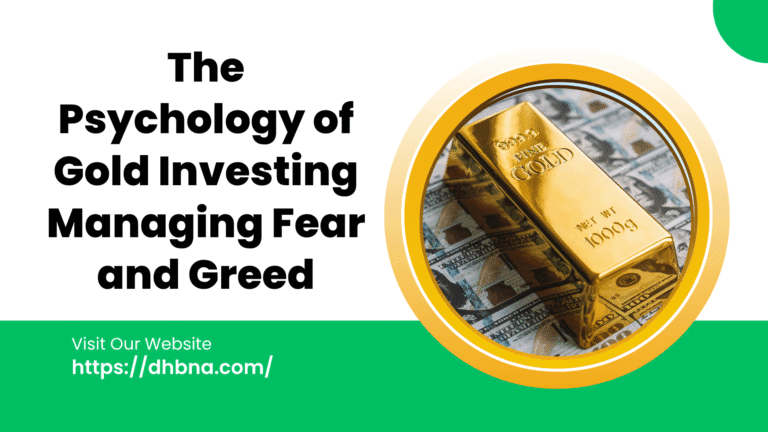Gold investing isn’t just about charts, yield curves, or central‑bank purchases. Beneath every price spike or sell‑off lies human emotion—fear and greed—that drives market sentiment. Understanding the psychology of gold investing means recognizing how these emotions influence decision‑making, learning to detach from herd behavior, and adopting disciplined strategies for sustainable returns. In this comprehensive guide, we’ll explore the cognitive biases and emotional triggers unique to gold, reveal practical techniques for emotion management, and offer actionable frameworks to help you navigate bull runs and downturns with confidence.
1. Why Psychology Matters in Gold Investing
1.1 Gold’s Unique Emotional Appeal
Gold has served as a store of value for millennia. Unlike equities or bonds, it carries deep cultural and psychological significance—a symbol of safety when currencies falter, wars loom, or inflation surges. This primal association magnifies emotional reactions:
- Fear spikes during geopolitical crises, prompting flight to bullion.
- Greed intensifies in commodity booms, fueling speculative buying.
Recognizing this unique emotional hook is the first step in mastering the psychology of gold investing.
1.2 Cognitive Biases at Play
Gold markets are especially prone to common biases:
- Recency bias: Over‐weighting recent price moves—“Gold returned 20% last year, so it must keep climbing.”
- Herd behavior: FOMO drives late buyers into parabolic rallies.
- Loss aversion: Fear of realizing losses leads to holding through steep drawdowns.
By understanding these biases, investors can build safeguards against impulsive, emotion‑driven trades.
2. Fear in Gold Investing: Triggers and Management
2.1 Sources of Fear
Fear in gold investing often arises from:
- Market volatility: Sharp pullbacks can trigger panic selling.
- Macro uncertainty: Unexpected inflation surprises or central‑bank pivots spark risk‑off flows.
- Liquidity crunches: In times of stress, even gold ETFs may widen spreads, amplifying fear.
2.2 Recognizing Fear‑Driven Behavior
Common fear‑driven mistakes include:
- Panic exits at the bottom—selling after a 10–15% correction.
- Over‑hedging—diverting too much into cash or short positions and missing rebounds.
- Constant monitoring—checking prices hourly leads to emotional whipsaw.
2.3 Strategies to Manage Fear
To navigate fear in gold investing psychology:
- Set rules: Pre‑define stop‑loss levels and position sizes (e.g., 5–10% of portfolio).
- Adopt staggered entries/exits: Scale into positions over days or weeks to average entry price.
- Use “Fear Index” signals: Monitor VIX, MOVE (bond volatility) or gold‑ETF flows to gauge panic levels.
- Maintain a long‑term anchor: Remind yourself of gold’s historical role—average annual returns ~8% real over decades.
By embedding these practices, you’ll be less prone to knee‑jerk reactions when markets gyrate.
3. Greed in Gold Investing: Traps and Discipline
3.1 Greed’s Allure
When gold rallies—perhaps on signs of aggressive Fed easing or fresh stimulus—investors feel FOMO (fear of missing out). Headlines trumpet new highs, fueling greed-driven buying near peaks.
3.2 Recognizing Greed‑Driven Behavior
Signs you may be succumbing to greed:
- Chasing tops: Buying when gold is up 5–10% in a short span without regard for valuation.
- Over‑leverage: Using margin or derivatives to amplify positions beyond prudent limits.
- Ignoring fundamentals: Buying purely on momentum while central‑bank data deteriorates.
3.3 Strategies to Control Greed
To temper greed within the psychology of gold investing:
- Define profit targets: Set realistic return objectives (e.g., 5–8% per quarter) and scale out at milestones.
- Implement trailing stops: Lock in gains by adjusting stop‑loss orders as price moves up.
- Diversify across assets: Avoid gold concentration above a predetermined allocation (e.g., 10–15% of total portfolio).
- Periodic rebalancing: Sell portions when gold’s weight in your portfolio exceeds targets, reinvesting into underweight assets.
These disciplined measures help you avoid euphoria‑driven overexposure.
4. Emotional Resilience: Building a Gold Investing Mindset
4.1 Developing Self‑Awareness
Accessing emotional intelligence is crucial:
- Daily journaling of trades and feelings helps identify emotional triggers.
- Mindfulness practices (brief meditations before trading) foster calm decision‑making.
4.2 The Role of Routine and Process
A structured process reduces emotional noise:
- Pre‑market checklist: Review macroeconomic calendar (CPI, Fed minutes).
- Technical scan: Identify key levels—50‑day /200‑day moving averages, Fibonacci retracements.
- Position sizing: Use fixed-percentage risk model (1–2% of equity per trade).
- Post‑trade review: Evaluate if trades followed the plan or slipped due to emotion.
4.3 Leveraging Technology
Modern tools can support emotional discipline:
- Algorithmic alerts: Price triggers notify you when levels hit, reducing screen‑watch anxiety.
- Automated orders: Pre‑set limit and stop orders so emotions don’t override your plan.
5. Integrating Psychology with Strategy
5.1 Tactical vs. Strategic Allocation
Balancing short‑term tactical trades with long‑term core positions lets you ride momentum while hedging fear. For example:
- Core holding: 5–7% of portfolio in physical gold or broad bullion ETFs.
- Tactical overlay: 1–2% in futures/options to capitalize on volatile swings.
Strategic core acts as emotional ballast; tactical trades harness greed in a controlled manner.
5.2 Scenario Planning
Anticipate regimes to prepare psychologically:
- Inflation shock: Maintain readiness to increase gold allocation if CPI tops 3%.
- Risk‑on pivot: Define clear sell‑down rules (e.g., gold underperforms S&P 500 by 2% in a week).
- Geopolitical flashpoint: Have pre‑approved buying scripts for rapid execution.
By mapping scenarios, you reduce decision despair during sudden market shifts.
6. Case Studies: Psychology in Action
6.1 The 2020 Pandemic Gold Rush
March 2020 saw gold briefly dip mid‑pandemic before shooting from $1,550 to $2,070 by August.
- Fear phase: Investors panicked in March—gold fell 10% as liquidity squeezed.
- Greed phase: From April onward, FOMO drove record ETF inflows, with many retail buyers piling on near $1,900.
- Lessons: Those who scaled in during the dip and used trailing stops captured most of the rally; late buyers near $2,000 suffered drawdowns when profit‑taking ensued.
6.2 2011 Peak Psychology
Gold peaked at $1,900 in September 2011 amid Eurozone debt fears.
- Greed extremes: Media hype and parabolic charts lured masses.
- Fear capitulation: By December, price collapsed 20%, sparking panic second‑guessing.
- Lessons: Setting profit targets and partial rebalances at psychological levels (e.g., round numbers) can safeguard gains.
7. Practical Checklists and Tools
7.1 Emotional Readiness Checklist
Before adjusting gold positions, ask:
- Am I trading based on new information or chasing headlines?
- Have I reviewed my stop‑loss and profit‑target rules?
- Are my position sizes within my risk tolerance?
- Am I comfortable stepping away if volatility spikes?
7.2 Recommended Tools
- Charting platforms with built‑in alerts (TradingView, Thinkorswim).
- Mobile meditation apps (Headspace, Calm) for stress reduction.
- Trading journals (Edgewonk, Tradervue) to track emotional triggers.
Conclusion
Mastering the psychology of gold investing means acknowledging that fear and greed will always color market behavior. By understanding emotional drivers, implementing structured risk‑management frameworks, and leveraging technology and self‑awareness techniques, you can transform psychological vulnerabilities into strategic strengths. The result: more disciplined entries and exits, lower emotional whipsaw, and ultimately, a more resilient gold investing approach poised for long‑term success.



